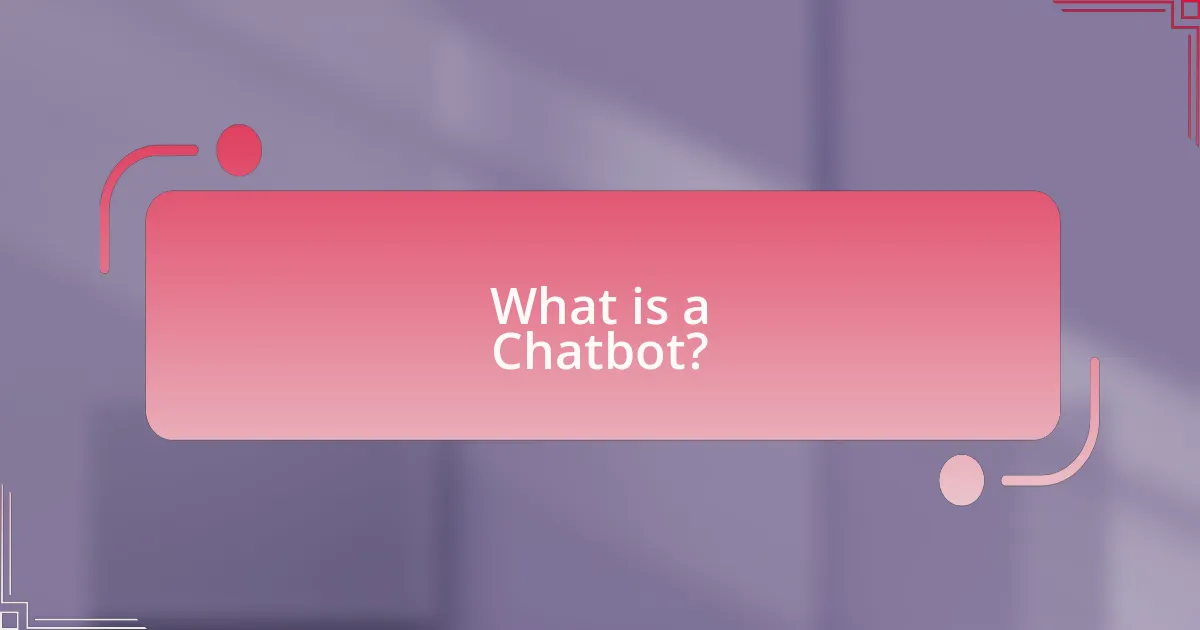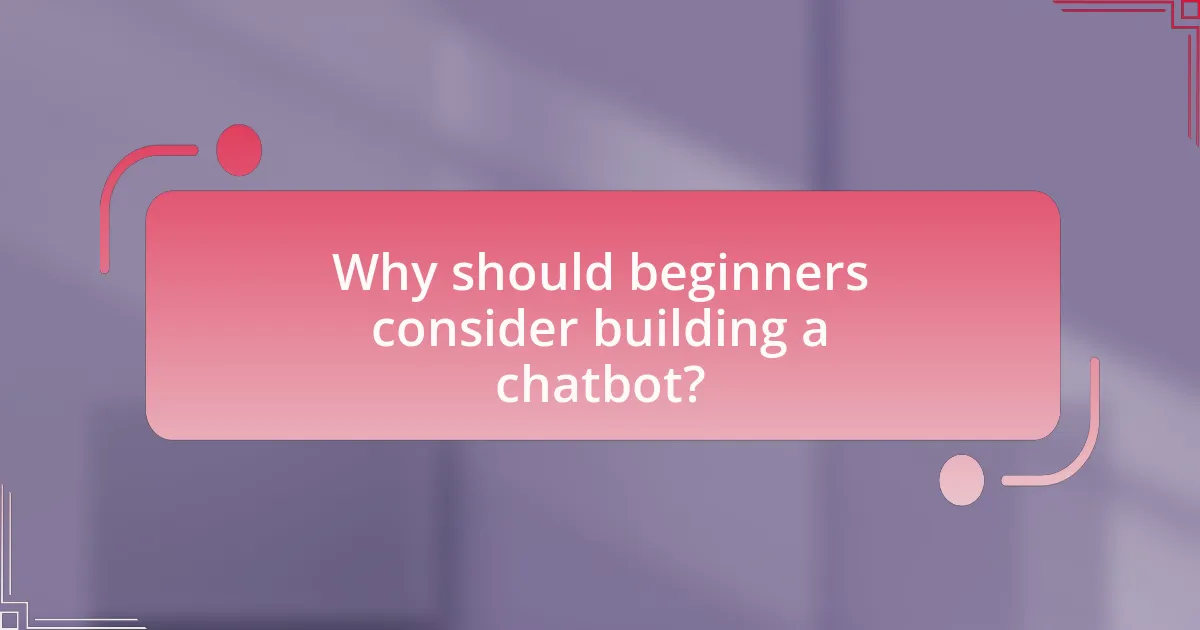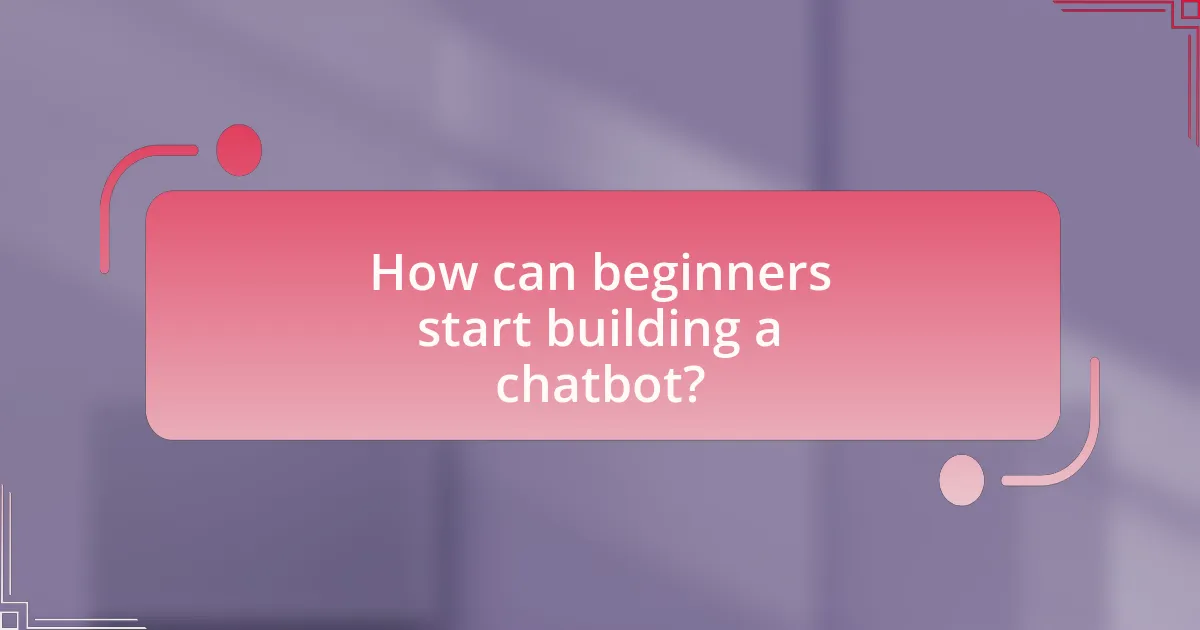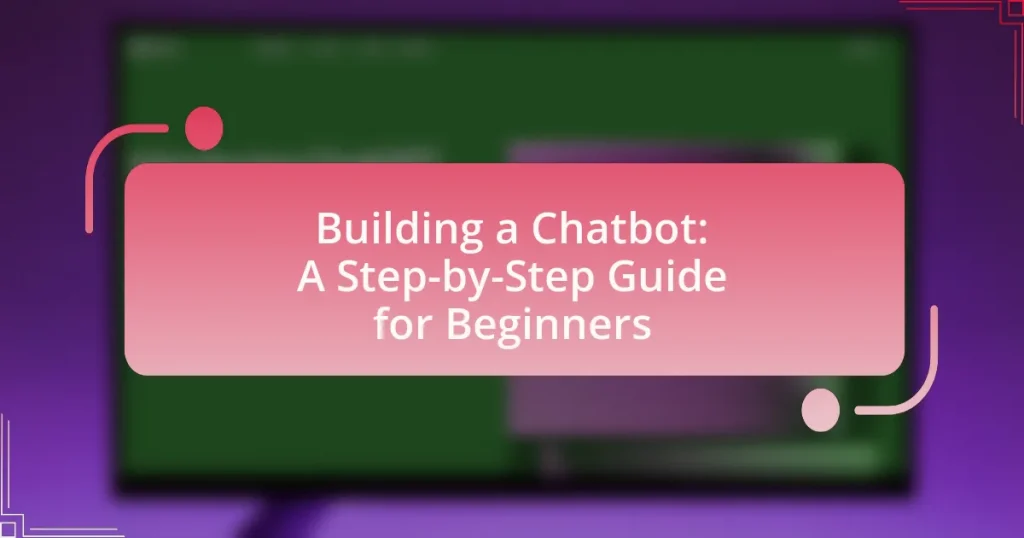The article focuses on building a chatbot, providing a comprehensive guide for beginners. It defines chatbots as software applications that simulate human conversation using natural language processing and machine learning. Key topics include the functionality of chatbots in digital communication, the technologies behind them, and the various types available. The article also outlines the benefits of creating a chatbot, necessary skills for development, and practical steps for implementation. Additionally, it addresses common challenges faced by beginners and offers strategies for improving chatbot performance over time.

What is a Chatbot?
A chatbot is a software application designed to simulate human conversation through text or voice interactions. These programs utilize natural language processing (NLP) and machine learning algorithms to understand user queries and provide relevant responses. Chatbots can be deployed in various platforms, including websites, messaging apps, and customer service systems, enhancing user engagement and operational efficiency. According to a report by Business Insider, the global chatbot market is expected to reach $1.34 billion by 2024, highlighting their growing significance in digital communication.
How do chatbots function in digital communication?
Chatbots function in digital communication by utilizing artificial intelligence and natural language processing to understand and respond to user inquiries in real-time. They analyze user input, identify intent, and generate appropriate responses, often through predefined scripts or machine learning algorithms. For instance, a study by IBM indicates that chatbots can handle up to 80% of routine customer inquiries, significantly improving response times and user satisfaction. This efficiency is achieved through continuous learning from interactions, allowing chatbots to adapt and enhance their conversational abilities over time.
What are the key technologies behind chatbot functionality?
The key technologies behind chatbot functionality include Natural Language Processing (NLP), Machine Learning (ML), and Application Programming Interfaces (APIs). NLP enables chatbots to understand and interpret human language, allowing for effective communication. ML algorithms help chatbots learn from interactions and improve their responses over time. APIs facilitate integration with other software systems, enabling chatbots to access data and services necessary for providing accurate and relevant information. These technologies collectively enhance the chatbot’s ability to engage users and deliver meaningful interactions.
How do chatbots understand and process user input?
Chatbots understand and process user input through natural language processing (NLP) techniques that analyze and interpret the text. These techniques involve tokenization, where the input is broken down into individual words or phrases, and intent recognition, which identifies the user’s purpose based on the input. Additionally, chatbots utilize machine learning algorithms to improve their understanding over time by learning from previous interactions. For instance, a study by Google Research demonstrated that NLP models can achieve high accuracy in intent classification, validating the effectiveness of these methods in chatbot functionality.
What types of chatbots exist?
There are primarily three types of chatbots: rule-based chatbots, AI-driven chatbots, and hybrid chatbots. Rule-based chatbots operate on predefined rules and scripts, responding to specific commands or keywords, making them suitable for straightforward tasks. AI-driven chatbots utilize natural language processing and machine learning to understand and respond to user queries more dynamically, allowing for more complex interactions. Hybrid chatbots combine elements of both rule-based and AI-driven systems, offering flexibility and efficiency in handling various user requests. This classification is widely recognized in the field of chatbot development, highlighting the varying capabilities and applications of each type.
What distinguishes rule-based chatbots from AI-driven chatbots?
Rule-based chatbots operate on predefined rules and scripts, while AI-driven chatbots utilize machine learning and natural language processing to understand and respond to user inputs. Rule-based chatbots follow a fixed set of instructions, limiting their ability to handle unexpected queries, whereas AI-driven chatbots learn from interactions, enabling them to adapt and improve over time. For example, a study by Gartner indicates that by 2025, 75% of customer service interactions will be powered by AI, highlighting the growing reliance on AI-driven solutions for more dynamic and effective communication.
How do different chatbot types serve various industries?
Different chatbot types serve various industries by addressing specific needs such as customer support, sales, and information dissemination. For instance, rule-based chatbots are commonly used in retail for handling FAQs and guiding customers through the purchasing process, while AI-driven chatbots are prevalent in healthcare for providing personalized patient interactions and appointment scheduling. According to a report by Business Insider, the global chatbot market is expected to reach $1.34 billion by 2024, indicating the growing reliance on chatbots across sectors. Additionally, chatbots in the banking industry streamline transactions and provide 24/7 customer service, enhancing user experience and operational efficiency.

Why should beginners consider building a chatbot?
Beginners should consider building a chatbot because it enhances their programming skills and provides practical experience in artificial intelligence. Engaging in chatbot development allows novices to learn about natural language processing, user interaction design, and backend integration, which are essential skills in today’s tech landscape. According to a report by Gartner, by 2025, 75% of customer service interactions will be powered by AI, highlighting the growing relevance of chatbots in various industries. This trend underscores the importance of gaining hands-on experience in chatbot creation for future career opportunities.
What are the benefits of creating a chatbot?
Creating a chatbot offers numerous benefits, including enhanced customer service, increased efficiency, and cost savings. Chatbots can provide 24/7 support, allowing businesses to respond to customer inquiries instantly, which improves customer satisfaction and engagement. According to a report by Juniper Research, chatbots are expected to save businesses over $8 billion annually by 2022 through reduced operational costs and improved service efficiency. Additionally, chatbots can handle multiple inquiries simultaneously, freeing up human agents to focus on more complex tasks, thereby optimizing workforce productivity.
How can chatbots enhance customer service?
Chatbots can enhance customer service by providing instant responses to customer inquiries, thereby improving response times and customer satisfaction. They operate 24/7, allowing businesses to assist customers outside of regular hours, which is crucial for global operations. According to a study by Juniper Research, chatbots are expected to save businesses over $8 billion annually by 2022 through improved efficiency and reduced operational costs. Additionally, chatbots can handle multiple inquiries simultaneously, reducing wait times and freeing human agents to focus on more complex issues. This capability leads to a more efficient customer service experience, as evidenced by a report from IBM, which states that chatbots can resolve up to 80% of routine inquiries without human intervention.
What cost savings can businesses achieve with chatbots?
Businesses can achieve significant cost savings with chatbots by reducing labor costs and improving operational efficiency. By automating customer service inquiries, chatbots can handle thousands of interactions simultaneously, which decreases the need for a large customer support team. For instance, a study by Juniper Research estimates that chatbots will help businesses save over $8 billion annually by 2022 through reduced operational costs. Additionally, chatbots can operate 24/7 without breaks, leading to increased productivity and faster response times, which enhances customer satisfaction and retention. This combination of reduced staffing needs and improved service efficiency directly translates to substantial financial savings for businesses.
What skills are necessary for building a chatbot?
To build a chatbot, essential skills include programming, natural language processing (NLP), and user experience (UX) design. Programming skills, particularly in languages like Python or JavaScript, enable developers to create the underlying logic and functionality of the chatbot. Natural language processing skills are crucial for understanding and processing human language, allowing the chatbot to interpret user inputs accurately. User experience design skills ensure that the chatbot interacts effectively and intuitively with users, enhancing engagement and satisfaction. These skills collectively contribute to the successful development and deployment of a functional and user-friendly chatbot.
What programming languages are commonly used in chatbot development?
Python, JavaScript, and Java are commonly used programming languages in chatbot development. Python is favored for its simplicity and extensive libraries, such as NLTK and TensorFlow, which facilitate natural language processing. JavaScript is essential for web-based chatbots, enabling real-time interactions through frameworks like Node.js. Java is often used in enterprise-level applications due to its scalability and robustness. These languages are widely adopted in the industry, supported by numerous resources and community contributions, making them effective choices for building chatbots.
How important is understanding natural language processing for chatbot creators?
Understanding natural language processing (NLP) is crucial for chatbot creators because it directly impacts the effectiveness and user experience of the chatbot. NLP enables chatbots to comprehend, interpret, and respond to human language in a meaningful way, which is essential for facilitating natural interactions. According to a study by McTear (2017), chatbots that leverage advanced NLP techniques can achieve higher user satisfaction and engagement rates, demonstrating the importance of this knowledge in creating functional and user-friendly chatbots.

How can beginners start building a chatbot?
Beginners can start building a chatbot by selecting a platform or framework that simplifies the development process, such as Dialogflow, Microsoft Bot Framework, or Rasa. These platforms provide user-friendly interfaces and pre-built templates that facilitate the creation of chatbots without extensive programming knowledge. For instance, Dialogflow allows users to create conversational agents using natural language processing, enabling them to understand and respond to user queries effectively. Additionally, beginners should familiarize themselves with basic concepts of chatbot design, such as intents, entities, and user flows, which are crucial for creating functional and engaging interactions.
What are the initial steps in chatbot development?
The initial steps in chatbot development include defining the purpose of the chatbot, identifying the target audience, and selecting the appropriate platform for deployment. Defining the purpose involves determining the specific tasks the chatbot will perform, such as customer support or information retrieval. Identifying the target audience helps tailor the chatbot’s language and functionality to meet user needs. Selecting the platform, whether it be a messaging app, website, or standalone application, is crucial for ensuring accessibility and user engagement. These steps lay the foundation for a successful chatbot that effectively serves its intended function.
How do you define the purpose and goals of your chatbot?
The purpose and goals of a chatbot are defined by its intended functionality and the specific needs it aims to address. For instance, a customer service chatbot is designed to provide instant support, answer frequently asked questions, and enhance user experience by reducing response times. Research indicates that chatbots can improve customer satisfaction by up to 70% when they effectively meet user needs (Gartner, 2020). Therefore, clearly outlining the chatbot’s objectives, such as increasing engagement, streamlining processes, or providing information, is essential for its successful implementation and user adoption.
What tools and platforms are available for chatbot creation?
Several tools and platforms are available for chatbot creation, including Dialogflow, Microsoft Bot Framework, and Chatfuel. Dialogflow, developed by Google, offers natural language processing capabilities and integrates with various messaging platforms. Microsoft Bot Framework provides a comprehensive environment for building, testing, and deploying chatbots across multiple channels. Chatfuel is a user-friendly platform that allows users to create chatbots for Facebook Messenger without coding. These platforms are widely used due to their robust features and ease of use, making them suitable for beginners in chatbot development.
What are the best practices for designing a chatbot conversation flow?
The best practices for designing a chatbot conversation flow include defining clear user intents, maintaining a logical structure, and ensuring user-friendly interactions. Clear user intents help the chatbot understand and respond accurately to user queries, which enhances user satisfaction. A logical structure, such as using decision trees or flowcharts, allows for smooth transitions between topics and prevents user confusion. User-friendly interactions involve using natural language, providing quick responses, and incorporating fallback options for unrecognized inputs, which collectively improve the overall user experience. These practices are supported by research indicating that well-structured conversation flows lead to higher engagement and satisfaction rates among users.
How can you create engaging and user-friendly dialogues?
To create engaging and user-friendly dialogues, focus on using clear, concise language that resonates with users. Engaging dialogues incorporate active listening techniques, allowing the chatbot to respond appropriately to user inputs, which enhances the interaction quality. User-friendly dialogues are structured to anticipate user needs, providing relevant options and prompts that guide the conversation naturally.
Research indicates that chatbots with a conversational tone and personalized responses lead to higher user satisfaction rates, as seen in studies by the Journal of Human-Computer Interaction, which found that 70% of users prefer chatbots that mimic human-like interactions. Additionally, employing feedback loops, where users can clarify or redirect the conversation, further improves engagement and usability.
What role does user feedback play in refining chatbot interactions?
User feedback is crucial in refining chatbot interactions as it provides direct insights into user experiences and preferences. By analyzing feedback, developers can identify areas where the chatbot may be underperforming, such as misunderstanding user queries or providing irrelevant responses. For instance, a study by Microsoft found that 70% of users are more likely to engage with a chatbot that learns from their feedback, indicating that iterative improvements based on user input can significantly enhance user satisfaction and engagement. This continuous loop of feedback and refinement leads to more effective and user-friendly chatbot interactions.
What common challenges do beginners face when building a chatbot?
Beginners face several common challenges when building a chatbot, including understanding natural language processing (NLP), designing effective conversation flows, and integrating with existing systems. The complexity of NLP can be daunting, as it requires knowledge of how to interpret user inputs accurately. Additionally, creating a seamless conversation flow is crucial for user engagement, yet many beginners struggle with structuring dialogues that feel natural. Finally, integrating the chatbot with platforms or databases can present technical hurdles, as it often involves coding and API usage that beginners may not be familiar with. These challenges highlight the need for foundational knowledge and practical experience in chatbot development.
How can you troubleshoot issues related to chatbot responses?
To troubleshoot issues related to chatbot responses, first analyze the conversation logs to identify patterns or recurring errors in the responses. This analysis helps pinpoint specific areas where the chatbot may be misunderstanding user inputs or failing to provide accurate information. Next, review the training data and algorithms used to ensure they are comprehensive and relevant to the intended use cases. Adjusting the training data can improve the chatbot’s understanding and response accuracy. Additionally, implement user feedback mechanisms to gather insights on response quality, which can guide further refinements. Regularly testing the chatbot in various scenarios will also help uncover hidden issues and improve overall performance.
What strategies can help improve chatbot performance over time?
To improve chatbot performance over time, implementing continuous learning and user feedback mechanisms is essential. Continuous learning allows the chatbot to adapt to new information and user interactions, enhancing its ability to provide relevant responses. User feedback mechanisms, such as post-interaction surveys, enable the collection of data on user satisfaction and areas for improvement. Research indicates that chatbots that utilize machine learning algorithms can increase accuracy by up to 30% when trained on diverse datasets, demonstrating the effectiveness of these strategies in enhancing performance.
What are some practical tips for successful chatbot implementation?
Successful chatbot implementation requires clear objectives, user-centric design, and continuous improvement. Establishing specific goals helps define the chatbot’s purpose, whether for customer support, lead generation, or information dissemination. Designing with the user in mind ensures that the chatbot meets user needs and expectations, enhancing engagement and satisfaction. Continuous monitoring and updating based on user interactions and feedback are essential for improving performance and relevance. Research indicates that chatbots can increase customer satisfaction by up to 70% when effectively implemented, highlighting the importance of these practical tips.










